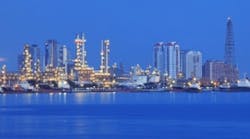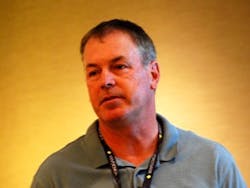Check Out Montague's Google+ profile.
The best process controls upgrade project is one that's so seamless, most people don't even know it's going on, says Kevin Kelley, process control foreman at Solvay Chemicals.It might seem impossible for such a huge, fast-moving and critical project to be so stealthy, but that's exactly what happened earlier this year at Solvay's trona ore mine and refinery in Green River, Wyoming. The facility migrated from Yokogawa Corp. of America's Centum CS3000 distributed control system (DCS) to its new Centum VP-R5 control system, and updated 21 field controllers and numerous other support components.
"We'd migrated from Honeywell's TDC to Yokogawa's CS3000 in 1998," said Kelley during his Sept. 9 presentation at the 2014 Yokogawa Users Conference and Exhibition in Houston. "So we had to upgrade now because our Microsoft Windows XP components were no longer supported in 2014, and their costs were going to go way up. We were scheduled for a five-year, total plant outage, and we needed to update our RIO field control stations with new templates and offline downloads that had never been done since they were initially installed. Also, we had an old infrastrucure with PCs that were seven years old, so we were having frequent hardware failures. We also needed to upgrade our system security to meet Solvay's overall corporate IT standards."
Solvay's control system at Green River has about 7,000 individual, hard-wired I/O points and about 3,000 communication I/O points for its SCADA system, PLCs, Honeywell FSC system and other packages. Its controls cover processes that are up to 20 miles apart, and its Yokogawa system resources include two domains, 21 RIO and FIO field control stations, 17 operator stations, six engineering stations and eight different plant servers.
World's Largest Trona Trove
"For the total upgrade, we experienced no loss of production, and the plant came back online without any problems. Next, we're undertaking a project to convert our graphics from the old 1990s style to more high-performance, alarm-oriented graphics.” Kevin Kelley, process control foreman at Solvay Chemicals.
All of these control systems and devices help extract and process Green River's abundant trona ore, which contains sodium sesquicarbonate, a relatively rare, sodium-rich mineral that's used to make soda ash. The mine and refinery's trona reserve in southwestern Wyoming is the largest and purest in the world, In fact, it contains 80% of the world's trona with more than 100 billion tons, including 40 billion tons that can be mined with conventional methods."The 10-foot seam we're currently mining is 1,600 feet below the surface and is 10 feet thick," reported Kelley. "We use four continuous bore miners to do room-and-pillar mining. They cut curved tunnels that are 8.5 to 9 feet high and 14.5 to 15 feet wide. We also do long-wall mining with equipment that's 10 to 11 feet high and 625 feet wide, and creates tunnels that are a mile long. We mine about 11,000 tons of ore per day from the mine."
Kelley adds that the Green River facility also is defined as a hard-rock, gassy mine because its operations also free about 6 million cubic feet of natural gas per day, which must be vented to keep the atmosphere in the mine at less than 2% methane. Solvay used to simply burn off this gas, but it recently implemented a capture system that gathers the natural gas from its long-wall operation and uses it to help run its refinery. "We were the first in the U.S. to use our waste natural gas as fuel, and we've been doing it for a couple of years," said Kelley. "We compress the 96% to 98% pure natural gas to about 70 psi, and send it to our kilns to subsidize our gas use, which gives us some carbon credits too."
Once the trona ore reaches the surface, it's crushed to 1/4 inch or less. Next, it's run through one of four calcination lines that cook the rock at 350 °F. Then water is used to leach out about 6,000 tons of pure trona per day. The resulting liquor is heavy with sodium sesquicarbonate, which is filtered, crystallized and dried into soda ash. This product is an essential ingredient in glass containers and other products, chemical manufacturing, soaps and detergents, flue gas desulfuring, pulp and paper, water treatment and other products and processes. The refinery also produces sodium sulfite and sodium bicarbonate.
Migration Is All About Timing
To keep its operation running smoothly, Kelley explained, "Our biggest challenge on this upgrade project was timing. The plant shutdown was scheduled for the last week of April 2014, and our total plant outage was the first Saturday and Sunday in May. However, although funds were slated for the upgrade two years ahead of time, they weren't fully committed until the first week of February 2014, making the purchasing process difficult and putting Yokogawa's standard lead time well past the shutdown deadline. This also made it difficult for us to have the time to install the needed upgrade to infrastructure, cabinets, switches, UPS racks, etc. Fortunately, Yokogawa worked very hard with us and went out of their way to meet our deadlines. The Yokogawa hardware arrived just in time to be installed."
Kelley reported it was of utmost importance that he and his colleagues at Solvay to perform their needed offline downloads while the plant was down. "We only had 12 hours to do the downloads while the plant power was out and before the power came back on, and the plant started coming back online," said Kelley. "We had to think of every part and piece ahead of time."
Besides installing servers, cabinets, control room equipment and other VP-R5 components that were much less cluttered than their CS3000 counterparts, Kelley added that some of Solvay's staff traveled to Yokogawa's Houston offices for Centum VP graphics evaluation and training. They determined what their new graphics would look like and evaluated Solvay's existing CS3000 database of more than 350 graphics to make sure it would cut over to VP's graphics.
"With our short cutover timeframe, it was important that we maximize our time to do the offline downloads and operator station replacements," reported Kelley. "This meant that we needed to have all of the infrastructure in place as much as possible when Yokogawa arrived. It involved months of prep work, spec-ing out parts and installing cabinets with UPS power, fiber runs for the KVMs and Vnet routing. We also pre-mounted the KVM units under the control desks. All we needed to do during the outage was to slide new machines in the racks and hook them up."
Cutover Time
The first phase of Green River's cutover involved one Yokogawa engineer, one Yokogawa service technician and four Solvay technicians, who pre-loaded workstations and staged them in the new cabinets. "We also ran reports before the offline downloads that showed us what the modes and status of each block in the control system were. These reports would be used after offline downloads to compare and identify the changes," added Kelley.
The second phase was Cutover Day and also the day of the plant outage. "The Yokogawa engineer upgraded the field control stations in System View software and performed offline downloads," added Kelley. "Immediately after the offline downloads, we ran the reports again and then ran a comparison report to identify all the changes in the block modes, so we could return them to the proper mode before the plant start-up. This was a big safety concern that took a few hours to complete."
The third phase was upgrading and verifying that Green River's OPC server was up, and that it was gathering data in its AspenTech plant historian. The team also upgraded and verified that its VTSPortal was fully functional and that other EXA and PRM software had the latest revisions.
"Finally, our operator and engineering stations were changed out live, one at a time," said Kelley. "Each operation area has two HISs. We changed out one station at a time, until each area had one VP station and one CS station. This took two days to complete, and it gave the operators time to get accustomed to the new stations. After the two days, we went around again and changed out the remaining stations. This worked well.
"For the total upgrade, we experienced no loss of production, and the plant came back online without any problems. About one month after the outage and cutover, a Yokogawa engineer returned to the site to do a follow-up. This gave us an opportunity to ask questions about VP-R5 and to tie up any loose ends. Next, we're undertaking a project to convert our graphics from the old 1990s style to more high-performance, alarm-oriented graphics."








